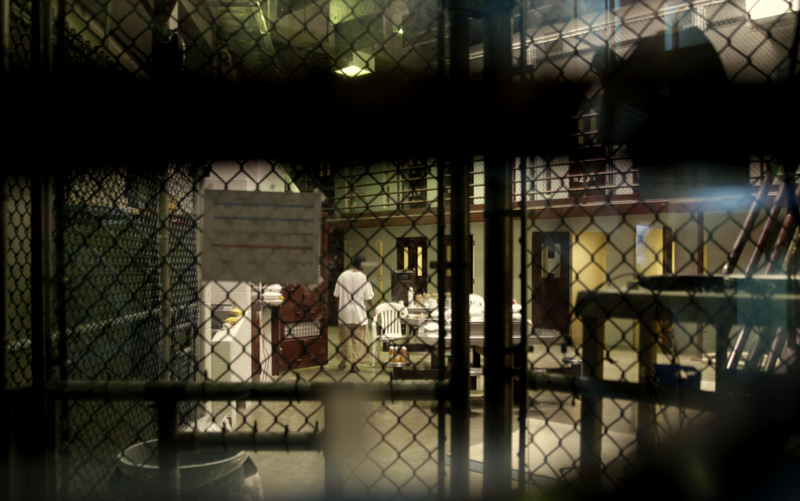
WASHINGTON — Within the next two weeks Judge Gladys Kessler of the U.S. District Court for the District of Columbia is expected to rule on alleged abusive force-feeding at Guantánamo Bay detention center in Cuba. Abu Wa’el Dhiab, a 43-year-old Syrian national and the father of four children, sued the Obama administration in 2013 in the first case of its kind to question the legality of force-feeding methods at the prison camp.
Yet Dhiab’s case is part of the wider scope of injustices inflicted on prisoners at Guantánamo Bay since it opened in early 2002.
“Essentially, Guantánamo is a massive massive mistake on the part of the U.S.,” said Katherine O’Shea, spokesperson for Reprieve, an international human rights NGO that represents prisoners at Guantánamo, while speaking with MintPress News. “The whole thing was misconceived from the start and now it’s very difficult for the administration to get itself out of.”
She was referring to the difficulties the Obama White House has faced in trying to close down the camp and extradite itself from the injustice of its existence. Shortly after Obama took office in 2009 he issued an executive order to have the camp closed within one year. It was reported earlier this month, however, that the White House is still looking for options on how to close the detention facility.
The detention center currently houses 149 prisoners, many of whom have spent over a decade incarcerated without being charged or given a trial.
Since January 2002, Guantánamo has housed 779 detainees. The Bush administration justified their capture and arrest in 2001 using a military order — “Detention, Treatment, and Trial of Certain Non-Citizens in the War Against Terrorism” — which authorized the Pentagon to hold people indefinitely without charge.
The legality of this law was upheld in 2011, when President Barack Obama signed into law the National Defense Authorization Act for fiscal year 2012, which allowed the indefinite detention, without trial, of those suspected of being involved in terrorism.
That law still applies, as MintPress News was reminded while speaking with Lt. Col. Myles Caggins, a public affairs officer for the U.S. Army. “All detainees are held under the ‘law of war,’” he said, asserting that the detainees’ “detention is just and justified.”
Detainee resistance

Detainees believe otherwise. They have pushed back through hunger strikes, the first of which occurred shortly after the prison opened in 2002.
According to inmates, a prison guard dropped a Quran and kicked it, which prompted the prison’s first hunger strike. That action was short-lived, as a senior officer apologized to the detainees and military personnel were restricted from handling the Quran, except in times of emergency.
Those hunger strikes, however, did not raise concerns about the well-being of the individuals involved.
Events took a more serious turn later in the year, when prisoners started to become aware of their unusual circumstances as prisoners of the U.S. military, but unfit to be charged or given trial. As a result, a hunger strike was organized from Feb. 27, 2002 to May 10, 2002, which involved up to 194 people at its peak, according to the Center for Constitutional Rights.
The military then struck back against this form of resistance. Three prisoners who had not eaten anything in 14 days were forcibly administered fluids for nourishment. This was done to stop the situation from escalating into something reminiscent of the 1981 Maze Prison hunger strike by Irish republicans in Northern Ireland, which resulted in the deaths of 10 people and attracted international media attention.
Force-feeding at Guantánamo has since become a regular practice. In an interview with The Dissenter, Cori Crider, counsel for detainees at the prison, said Emad Hassan, 35, “has been on continuous hunger strike since 2007.” The inmate has been held for 12 years without being charged or even formally accused. Further, he has been cleared for release, which means he is innocent of any crime.
“Think of that for a minute. That means that he has been force-fed twice a day, every day, several thousand times. I’m not sure in the history of force-feeding anywhere whether there is anybody who has gone through the process for so long,” Crider said.
Detainees have also staged other types of protests aimed at demanding justice for how they are treated and to address their peculiar situation at the island prison. Detainees sometimes do not change clothes as a form of resistance or make attempts to inflict self-harm.
In August 2003, 23 detainees attempted to kill themselves. The Center for Constitutional Rights’ report states, “The mass suicide attempts were among 350 ‘self-harm’ incidents reported by the military in 2003, which included 120 ‘hanging gestures.’ The coordinated August 2003 mass suicide attempt included ten simultaneous attempts on August 22. This protest followed Major General Geoffrey Miller’s taking of command at Guantánamo with a mandate to acquire more information from prisoners accused of associations with the Taliban or Al Qaeda.”
Meanwhile, hunger strikes have continued unabated.
Torture

The current method for force-feeding prisoners at Guantánamo involves strapping a detainee to a restraint chair and administering liquid food to the prisoner through a tube that runs through the nose and down into the stomach, according to The New York Times.
Gen. Bantz J. Craddock, the military commander who was in charge of Guantánamo Bay in 2006, told reporters at the time that commanders at the prison decided to make life uncomfortable for hunger-strikers. Craddock said that upon the implementation of those methods, which included the use of restraint chairs, that form of protest was no longer “convenient” for detainees. He quoted inmates as saying, “I don’t want to put up with this. This is too much of a hassle.”
It seems that the methods devised to force-feed hunger-striking detainees were purposefully made more painful to stop them from continuing their actions. The American Medical Association and the World Medical Association have both condemned force-feeding practices, and just this year a nurse at Guantánamo refused to participate in enteral feedings, saying the practice is inhumane. Writing for The Guardian, Crider, Dhiab’s counsel, quoted the nurse as saying: “I have come to the decision that I refuse to participate in this criminal act.”
The Department of Defense says otherwise. “We’re in charge of safe-guarding them, which means that we will not let them harm themselves through refusing meals over extended periods of time. So we take action that’s fully in compliance and consistent to how the U.S. Federal Bureau of Prisons were to conduct enteral feedings, and in no way is it torture to keep a person from harming themself by having medical professionals ensure they have adequate nutrition,” said Caggins, the Army’s public affairs officers, while speaking with MintPress.
The New York Times quoted one prisoner’s description of the procedure. He said, “The head is immobilized by a strap so it can’t be moved, their hands are cuffed to the chair and the legs are shackled… They ask, ‘Are you going to eat or not?’ and if not, they insert the tube. People have been urinating and defecating on themselves in these feedings and vomiting and bleeding. They ask to be allowed to go to the bathroom, but they will not let them go. They have sometimes put diapers on them.”
Video footage
In 2013, for the first time, a group of hunger-striking detainees filed a lawsuit against the U.S. government to stop force-feeding altogether in the case known as Aamer v. Obama. So far, the courts have refused to grant this request.
However, the Dhiab v. Obama case has made headway regarding the treatment of prisoners being force-fed. Dhiab has filed an injunction that would bar the government from forcibly removing him from his cell “and from placing him in a Five-Point Restraint Chair for the purpose of transporting him to or from forced-feeding, so long as he indicates that he is willing to submit to such feeding compliantly.”
A ruling is expected “in the next couple of weeks,” O’Shea, the spokesperson for Reprieve, told MintPress. She added that Dhiab’s case is particularly important because he has never been charged with a crime, he has been cleared to leave the prison for five years, and “he doesn’t believe he’ll ever go home.”
Yet the government has made a deal with Uruguay to transfer Dhiab and five other prisoners to the South American nation, although it is unclear when that will happen.
Dhiab’s case has also opened up the possibility for the public to view recordings of force-feeding practices at Guantánamo, which is hoped will renew public dialogue about the facility and help facilitate an end to its existence. On Oct. 3, Judge Kessler ordered the government to release redacted footage of the procedure to media companies. Crider, who has viewed the footage, said, “While I’m not allowed to discuss the contents of these videos, I can say that I had trouble sleeping after viewing them. I have no doubt that if President Obama forced himself to watch them, he would release my client tomorrow.”
Kessler granted a motion for the government to hold off on releasing the video footage of Dhiab’s forced cell extraction and force-feeding until Nov. 16.
Crider said in a press release, “Our client has been put through day after day of gratuitous pain at Guantánamo, for the simple reason that the authorities are determined to break his peaceful hunger strike. Enough is enough. The government refuses to acknowledge our client’s suffering – indeed, they insist he needs no wheelchair. Let’s hope this case will clean up some of the worst abuses still going on at Gitmo today, and that Americans will be permitted to see the videotapes, so they know what is really being done in our name.”
Emad Hassan, the hunger-striking detainee previously mentioned by Crider, filed a lawsuit against the government in May of this year to challenge force-feeding as a form of torture. That case has yet to be heard.

